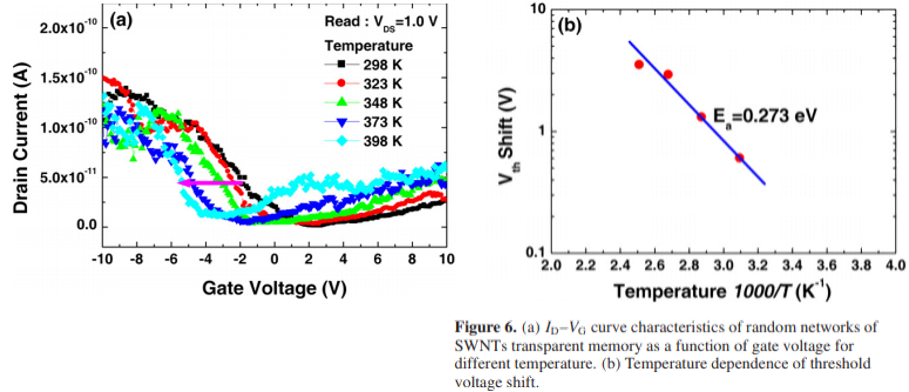Memory effects based on random networks of single-walled carbon nanotubes
We have fabricated memory devices based on random networks of single-walled carbon nanotubes (SWNTs) on a glass substrate. The characteristics of the nonvolatile memory were investigated as a function of gate voltage, pulse time, and temperature. The program/erase window was greater than approximately 3.2 V. The gate voltage sensitivity of the erase speed was greater (~1.9 times) than that of the program speed. The activation energy was about 0.273 eV. The mechanism could be explained from the polarization of water molecules, and may provide an important insight into the program/erase operation of memory devices. We have also discussed a fast erase speed due to a work function difference and oxide trapped charges.
- Single-walled carbon nanotube
- SiOx
- Buffer layer
- GZO film
- PET substrate

Figure 6(a) shows the strong temperature dependence observed in our data. As the temperature increased, the threshold voltage moved to the left from the programmed state due to water molecule desorption. The ID–VG curve characteristics for random networks of SWNTs substrate memory devices behaved similarly to the erase operation curve above a temperature of 373 K. The activation energy Ea can be calculated from the Arrhenius equation ‘Vth = A exp(−Ea/kT )’, where A is the pre-exponential factor, T is the thermodynamic temperature, and k is the Boltzmann constant. Here, the activation energy Ea is about 0.273 eV, as shown in figure 6(b), indicating very weak retention characteristics by charge detrapping as compared to the commercial retention time of 10 year.
 Encyclopedia
Encyclopedia



